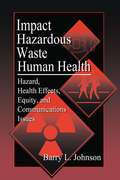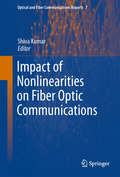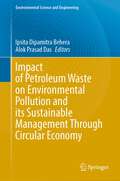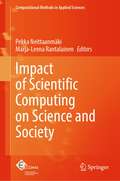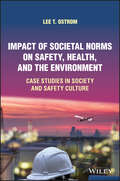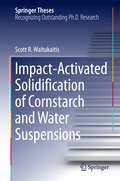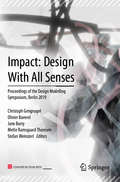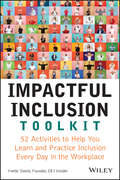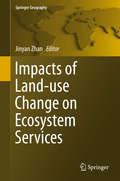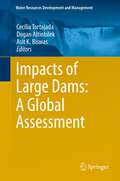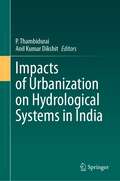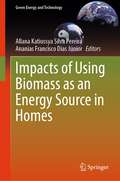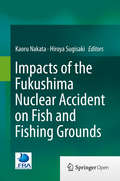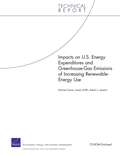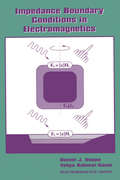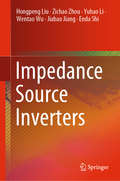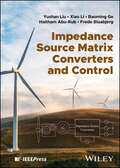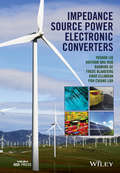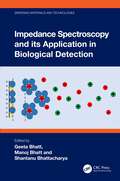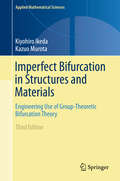- Table View
- List View
Impact of Government Expenditure on Growth: The Case of Azerbaijan
by Junko Koeda Vitali KramarenkoA report from the International Monetary Fund.
Impact of Hazardous Waste on Human Health: Hazard, Health Effects, Equity, And Communications Issues
by Barry L. JohnsonThe author of Impact of Hazardous Waste on Human Health is a public health official with the unique perspective that only insider status can provide. His book is intended for policy makers, environmentalists, toxicologists, public health officials, academic personnel, and health care providers. The author addresses six themes: hazardous waste issues must be more vigorously examined, site remediation is critical, risk management must extend beyond waste site clean up, disease prevention must be a priority, interagency partnership is mandatory, and the best technology must be applied. Johnson also considers the pros and cons of the Comprehensive Environmental Response, Compensation, and Liability Act (CERCLA) also known as the "Superfund." His years of experience with this law, and countless other issues related to hazardous waste, make Impact of Hazardous Waste on Human Health an important and positive contribution.
Impact of Nonlinearities on Fiber Optic Communications
by Shiva KumarThis book covers the recent progress in fiber-optic communication systems with a main focus on the impact of fiber nonlinearities on the system performance. Over the past few years, there has been significant progress in coherent communication systems mainly because of the advances in digital signal processing techniques. This has led to renewed interest in fiber linear and nonlinear impairments and techniques to mitigate them in electrical domain. In this book, the reader will find all the important topics of fiber optic communication systems in one place with in-depth coverage by the experts of each subtopics. Pioneers from each of the sub-topics have been invited to contribute. Each chapter will have a section on fundamentals, review of literature survey and the recent developments. The reader will benefit from this approach since many of the conference proceedings and journal articles mainly focus on the authors' research work without spending space on preliminaries.
Impact of Petroleum Waste on Environmental Pollution and its Sustainable Management Through Circular Economy (Environmental Science and Engineering)
by Alok Prasad Das Ipsita Dipamitra BeheraThe purpose of this book is to discuss the challenges that have arisen due to petroleum hydrocarbon wastes, their harmful effects to the ecosystem, and limitations as well as improvement of current biological techniques’ use for management of petroleum hydrocarbon wastes. This book focuses on the role of advanced green engineering technologies for sustainable petroleum waste management in building an economic supportable society as a basic need of developing countries. The rapid economic growth achieved in last decade has been paralleled by an increase in global energy consumption resulting generation of massive amount of industrial wastes. Petroleum wastes release through spillages and leakage from underground tanks, steamers, unplugging of oil wells, and abandoned oil refinery sites that cause extensive contamination of surface soils, groundwater, seas, and ocean resulting in ecosystem damage. Apart from these, petroleum industries release a significant amount of hydrocarbon wastes during processing of crude oil. Improper waste management technique of these petroleum wastes may cause a serious effect toward the living beings. The presence of these hazardous wastes in the environment will make vulnerable conditions to the aquatic as well as terrestrial life. Till date, a number of conventional techniques have been implemented to treat these petroleum hazardous wastes, but biological treatment is more efficient among all on basics of economic and environmental point of view. Bioaugmentation, biostimulation, and combinatorial bioaugmentation and biostimulation waste management strategies are implemented to treat these wastes. In addition to these techniques, biocomposting/biopile, land treatment, and bio-slurry methods have also been employed to reduce the endanger effects of petroleum wastes. Integrating waste management through environmental sustainability and economic development is one of the prime milestones in the circular economy. There is an exigent necessity for developing countries to go ahead toward a circular economy for achieving its Sustainable Development Goals.
Impact of Plastic Waste on the Marine Biota
by Mohd. Shahnawaz Manisha K. Sangale Avinash B. Ade Zhu DaochenThis contributed volume focuses on the effects of macro, meso, micro, and nanoplastic waste on marine biota. It discusses the threats posed by plastic waste on the flora and fauna in the marine environment. This book will help in understanding different aspects of plastic waste generation, its transportation with different natural and anthropogenic ways, its accumulation at the seacoast, and its impact on marine biota. The book also suggests strategies for saving marine life from threats posed by plastic waste and presents methods to reduce its generation using different strategies. This book is of interest to teachers, researchers, climate change scientists, capacity builders, and policymakers. It also serves as additional reading material for undergraduate and postgraduate students of Ecology, Botany, and Environmental Sciences.
Impact of Science on African Agriculture and Food Security
by P. Anandajayasekeram M. Rukani S. Babu F. Liebenberg C. L. KeswaniThe need for agricultural research resources in the developing world cannot be underestimated, but the availability of such resources is often poor due to lack of funding and investment. In order for Africa and other such developing countries to achieve productivity in agriculture - vital to food security, poverty reduction and sustainable management of natural resources - investment and policy development needs to be assessed. This book, a joint effort from IFPRI, ILRI and the Kellogg Foundation, explores the importance of impact assessment studies in Africa, and assembles important evidence to pave the way for further, much needed investment in agricultural research all over the developing world.
Impact of Scientific Computing on Science and Society (Computational Methods in Applied Sciences #58)
by Pekka Neittaanmäki Marja-Leena RantalainenThis book analyzes the impact of scientific computing in science and society over the coming decades. It presents advanced methods that can provide new possibilities to solve scientific problems and study important phenomena in society. The chapters cover Scientific computing as the third paradigm of science as well as the impact of scientific computing on natural sciences, environmental science, economics, social science, humanistic science, medicine, and engineering. Moreover, the book investigates scientific computing in high performance computing, quantum computing, and artificial intelligence environment and what it will be like in the 2030s and 2040s.
Impact of Societal Norms on Safety, Health, and the Environment: Case Studies in Society and Safety Culture
by Lee T. OstromA compelling exploration of how social norms and commercial culture impact the safety of organizational operations In Impact of Societal Norms on Safety, Health, and the Environment: Case Studies in Society and Safety Culture, distinguished engineer Dr. Lee T. Ostrom delivers an authoritative treatment of the cultural, social, and human factors of safety cultures and issues in the workplace. The book offers readers compelling discussions of how those factors impact organizational operations and what contributes to making those impacts beneficial or detrimental. The author provides numerous real-world case studies from North America and Europe that are relevant to a global audience, highlighting the central message of the book: that an organization that views its safety culture as unimportant could be setting itself up for a significant workplace accident. Readers will also find: A thorough introduction to social norms that impact how commercial organizations treat issues of safety and workplace health In-depth safety culture case studies from North America and Europe Comprehensive explorations of how peoples&’ perceptions of hazards impact workplace operations and the daily lives of employees Fulsome discussions of the effect of societal attitudes on workplace health and safetyPerfect for industrial and safety managers, safety coordinators, and safety representatives, Impact of Societal Norms on Safety, Health, and the Environment will also earn a place in the libraries of industrial hygienists, ergonomic program coordinators, and HR professionals.
Impact!: Asteroids and the Science of Saving the World
by Elizabeth Rusch Karin AndersonAsteroids bombard our atmosphere all the time. Some are harmless, burning up in a flash of light. But others explode with a great sonic boom, smashing windows and throwing people to the ground. Worst of all, some asteroids strike our planet, blasting out massive craters and destroying everything nearby on impact. Follow the award-winning author Elizabeth Rusch into the field with scientists as they search for dangerous asteroids in space, study asteroids that have smashed into the ground, and make plans to prevent an asteroid strike if one ever threatens our planet.
Impact-Activated Solidification of Cornstarch and Water Suspensions
by Scott R. WaitukaitisThis thesis approaches impact resistance in dense suspensions from a new perspective. The most well-known example of dense suspensions, a mixture of cornstarch and water, provides enough impact resistance to allow a person to run across its surface. In the past, this phenomenon had been linked to "shear thickening" under a steady shear state attributed to hydrodynamic interactions or granular dilation. However, neither explanation accounted for the stress scales required for a person to run on the surface. Through this research, it was discovered that the impact resistance is due to local compression of the particle matrix. This compression forces the suspension across the jamming transition and precipitates a rapidly growing solid mass. This growing solid, as a result, absorbs the impact energy. This is the first observation of such jamming front, linking nonlinear suspension dynamics in a new way to the jamming phase transition known from dry granular materials.
Impact: Proceedings of the Design Modelling Symposium, Berlin 2019
by Christoph Gengnagel Jane Burry Mette Ramsgaard Thomsen Stefan Weinzierl Olivier BaverelThis book reflects and expands on the current trend in the building industry to understand, simulate and ultimately design buildings by taking into consideration the interlinked elements and forces that act on them. Shifting away from the traditional focus, which was exclusively on building tasks, this approach presents new challenges in all areas of the industry, from material and structural to the urban scale. The book presents contributions including research papers and case studies, providing a comprehensive overview of the field as well as perspectives from related disciplines, such as computer science. The chapter authors were invited speakers at the 7th Symposium “Impact: Design With All Senses”, which took place at the University of the Arts in Berlin in September 2019.
Impactful Inclusion Toolkit: 52 Activities to Help You Learn and Practice Inclusion Every Day in the Workplace
by Yvette SteelePractical, hands-on strategies to increase inclusion, diversity, and equity in your workplace In Impactful Inclusion Toolkit: 52 Activities to Help You Learn and Practice Inclusion Every Day in the Workplace, accomplished diversity, equity, and inclusion (DEI) strategist and leader Yvette Steele delivers a collection of practical and hands-on exercises that encourage and promote inclusion in the workplace. The exercises emphasize the development of key inclusive behaviors, including self-knowledge, connecting with others, creating new habits, and experiencing other cultures. In the book, you&’ll find: 52 behaviors to practice during the year that will empower you to be more inclusive in the real world Concrete instructions regarding how to become more inclusive, rather than just high-level information about inclusivity generally Actionable strategies to help drive change in your organization and manage the discomfort that sometimes exists around DEI issues An effective and practical resource for anyone who wants to be more inclusive. Frontline and knowledge workers can empower themselves to drive change with weekly activities and resources. DEI and HR professionals, company founders, owners, managers, and other business leaders can better support staff on their inclusion journey. The Impactful Inclusion Toolkit is an essential addition to DEI strategies of any organization whether they are active or aspire to be more inclusive.
Impacts of Land-use Change on Ecosystem Services
by Jinyan ZhanThis book aims to systematically elaborate how land-use change directly or indirectly exerts impacts on the ability of ecosystems to provide services for human society. The relationship between land use, ecosystem services and human well-being is a hot topic, and there have been some important achievements in this field, but its continuing growth means that it warrants further research. The unique viewpoint, the scientific analysis methods and the precise language of this book make it not only a valuable guide for professors conducting research, but also a reference resource to help governments make decisions on relevant policies. Prof. Jinyan Zhan is an associate professor at the School of Environment, Beijing Normal University, China.
Impacts of Large Dams: A Global Assessment
by Asit K. Biswas Cecilia Tortajada Dogan AltinbilekOne of the most controversial issues of the water sector in recent years has been the impacts of large dams. Proponents have claimed that such structures are essential to meet the increasing water demands of the world and that their overall societal benefits far outweight the costs. In contrast, the opponents claim that social and environmental costs of large dams far exceed their benefits, and that the era of construction of large dams is over. A major reason as to why there is no consensus on the overall benefits of large dams is because objective, authoritative and comprehensive evaluations of their impacts, especially ten or more years after their construction, are conspicuous by their absence. This book debates impartially, comprehensively and objectively, the positive and negative impacts of large dams based on facts, figures and authoritative analyses. These in-depth case studies are expected to promote a healthy and balanced debate on the needs, impacts and relevance of large dams, with case studies from Africa, Asia, Australia, Europe and Latin America.
Impacts of Selenium on the Biogeochemical Cycles of Mercury in Terrestrial Ecosystems in Mercury Mining Areas
by Hua ZhangFrom a new perspective, namely focusing on the interaction of selenium and mercury, this thesis provides new insights into traditional research on biogeochemical cycles of mercury in soil-plant interaction and associated human exposure and risks. The subject of this thesis is both valuable and timely, providing essential information not only on selenium-mercury interaction in the soil-plant system but also on how to assess the combined benefits and risk of co-exposure to mercury and selenium. This work also sheds light on future aspects regarding prevention, remediation and risk management for environmental mercury contamination. Presenting high-quality papers published in leading international SCI journals such as Environmental Health Perspectives and Environmental Science & Technology and having been recognized with the Special Award of Presidential Scholarship Award and Excellent Doctoral Dissertations Prize of the Chinese Academy of Sciences (CAS), this thesis offers a valuable resource for scientific communities, policy-makers and non-experts who are interested in this field. Dr. Hua Zhang works at the Norwegian Institute for Water Research (NIVA), Oslo, Norway.
Impacts of Urbanization on Hydrological Systems in India
by Anil Kumar Dikshit P. ThambiduraiThis book documents the various impacts of urbanization on hydrological systems and water resources. The first half of the book is focused on urbanization and surface waters, starting with the status of hydrological systems in the urban areas, i.e. the catchment characteristics and changes in rainfall dynamics. The most pronounced hydrological problems in cities are changes in runoff due to precipitation. Recently, rain events have been less frequent but more intense, sometimes leading to flash floods. Though the substantial increase in runoff causes floods in the urbanized area, it may be attributed to the reduction of infiltration due to construction of roads. This, in turn, results in groundwater decline and depletion. The second half of the book covers the impact of urbanization on groundwater, which starts with hindered or significantly reduced recharge taking place due to altered urban surfaces. The limited groundwater resources are over-exploited by the urban population, leading to water scarcity and depletion. Groundwater gets polluted due to solid waste dumping sites or by wastewaters discharged by industries. The book will be useful for researchers, educators, municipal/city authorities, government officials, and NGOs.
Impacts of Using Biomass as an Energy Source in Homes (Green Energy and Technology)
by Allana Katiussya Silva Pereira Ananias Francisco Dias JúniorThe book deepens understanding of biomass sources and technologies used for cooking worldwide. It contributes directly to the creation of policies aimed at the mitigation of climate change.Historically, wood is considered humanity's first source of energy. Even after decades of use and industrialization processes, it is still considered the most important single source of renewable energy. About a third of the world's population is energetically dependent on wood for cooking and/or heating. Recently, the Covid-19 pandemic made it impossible to purchase fuels such as liquefied petroleum gas (LPG), forcing families in financial difficulties to opt for cheaper and more accessible sources of energy, such as wood and vegetable coal. This has been the picture of many families around the world and negatively impacts the environment and energy security. Considering that there are still many wood residues that are wasted and that tropical forests need to be conserved, knowledge about the energy use of wood residues is also essential. This is even more relevant when considering the significant volume of biomass coming from the sustainable management of the largest tropical forest in the world, the Amazon Forest.The book considers which wood variables should be taken into account when thinking about energy generation, how do food cooking technologies contribute to potentiating pollutants emissions, and how can these harmful effects be mitigated. It describes the chemical composition of biomass and the chemical compounds released during its burning, as well as their impacts on the environment and human health. It also presents the influence that technologies used in food cooking have on pollutant emissions and which alternatives can be used, such as the use of solar energy.
Impacts of the Fukushima Nuclear Accident on Fish and Fishing Grounds
by Kaoru Nakata Hiroya SugisakiThis book presents the results from the Japanese Fisheries Research Agency's 3-year intensive monitoring of radionuclides in a variety of fish, plankton, benthos, and their living environments after the Fukushima Daiichi Nuclear Power Plant (FNPP) accident in March 2011. The book reveals the dynamics of contamination processes in marine and freshwater fish, mediated by the contamination of water, sediments, and food organisms; it also clarifies the mechanisms by which large variations in the level of contamination occurs among individual fish. Most importantly, the book includes a large amount of original measurement data collected in situ and for the first time assesses diffusion of radiocesium across the Pacific using both in situ data and a numerical simulation model. Also introduced are several new approaches to evaluate the impact of the release of radionuclides, including the measurement of radiation emission from an otolith section to identify the main period of contamination in fish. The FNPP accident represents a rare instance where the environmental radioactivity level was elevated steeply through atmospheric fallout and direct discharge of radioactive water into the sea over a short period of time. Replete with precise scientific data, this book will serve as an important resource for research in fields such as fishery science, oceanography, ecology, and environmentology, and also as a solid basis for protecting fisheries from damage resulting from harmful rumors among the general public.
Impacts on U.S. Energy Expenditures and Greenhouse-Gas Emissions of Increasing Renewable-Energy Use
by Robert J. Lempert Michael Toman James GriffinHow could producing 25 percent of U.S. electricity and motor-vehicle transportation fuels from renewables by the year 2025 affect U.S. consumer energy expenditures and CO2 emissions? This report finds that reaching 25 percent renewables with limited impact on expenditures requires significant progress in renewable-energy technologies and biomass production. Without substantial innovation in these areas, expenditures could increase considerably.
Impedance Boundary Conditions In Electromagnetics
by Daniel J. HoppeElectromagnetic scattering from complex objects has been an area of in-depth research for many years. A variety of solution methodologies have been developed and utilised for the solution of ever increasingly complex problems. Among these methodologies, the subject of impedance boundary conditions has interested the authors for some time. In short, impedance boundary conditions allow one to replace a complex structure with an appropriate impedance relationship between the electric and magnetic fields on the surface of the object. This simplifies the solution of the problem considerably, allowing one to ignore the complexity of the internal structure beneath the surface. This book examines impedance boundary conditions in electromagnetics. The introductory chapter provides a presentation of the role of the impedance boundary conditions in solving practical electromagnetic problems and some historical background. One of the main objectives of this book is to present a unified and thorough discussion of this important subject. A method based on a spectral domain approach is presented to derive the Higher Order Impedance Boundary Conditions (HOIBC). The method includes all of the existing approximate boundary conditions, such as the Standard Impedence Boundary Condition, the Tensor Impedence Boundary Condition and the Generalised Impedance Boundary Conditions, as special cases. The special domain approach is applicable to complex coatings and surface treatments as well as simple dielectric coatings. The spectral domain approach is employed to determine the appropriate boundary conditions for planar dielectric coatings, chiral coatings and corregated conductors. The accuracy of the proposal boundary conditions is discussed. The approach is then extended to include the effects of curvature and is applied to curved dielectric and chiral coatings. Numerical data is presented to critically assess the accuracy of the results obtained using various forms of the impedence boundary conditions. A number of appendices that provide more detail on some of the topics addressed in the main body of the book and a selective list of references directly related to the topics addressed in this book are also included.
Impedance Source Inverters
by Hongpeng Liu Zichao Zhou Yuhao Li Wentao Wu Jiabao Jiang Enda ShiThis book focuses on impedance source inverters, discussing their classification, advantages, topologies, analysis methods, working mechanisms, improvements, reliability, and applications. It summarizes methods for suppressing DC-link voltage spikes and duty loss, which can pose a problem for researchers; and presents novel, efficient, steady state and transient analysis methods that are of significant practical value, along with specific calculation examples. Further, the book addresses the reliability of impedance source inverters, adopting a methodology from reliability engineering to do so. Given its scope, it offers a valuable resource for researchers, engineers, and graduate students in fields involving impedance source inverters and new energy sources.
Impedance Source Matrix Converters and Control
by Haitham Abu-Rub Yushan Liu Baoming Ge Frede Blaabjerg Xiao LiTechnical resource presenting the latest power conversion solutions to advance the role of AC-AC power electronics in various applications. Compiling state-of-the-art research from around the world, Impedance Source Matrix Converters and Control provides a rich diversity of scientific work experience and scholarly approaches on the fundamentals and advances of power electronic converters for motor drives, renewable energies, and industry applications. The reader will be able to apply the learnt design approaches in this book for building and researching the future generation of efficient power electronic converters: more efficient, more reliable, less expensive, lighter, and less voluminous. The text introduces impedance source matrix converters in four distinct parts, covering the basics, converter topology, control, and applications. Its main focus is on the detailed understanding of advanced concepts related to fundamentals of impedance source matrix converters, and provides associated models, analysis, modulation, and final design and optimization control. Additional tables, questions/answers, tutorials, PowerPoint presentations, and selected simulation and experimental results are discussed in order to impart seamless reader comprehension. Written by four highly qualified academics with significant experience in the field, Impedance Source Matrix Converters and Control covers sample topics such as: Operating principles and modulation methods for impedance source direct/indirect matrix converters and 3-1-phase matrix converters Optimum operation control of LC filter integrated impedance source indirect matrix converters and comparison and control strategies of typical impedance source matrix converters Design and improvement in the electricity supply’s reliability, efficiency, compact volume, power quality, and sustainability Challenges and key technologies within the field of impedance source matrix converters, and solutions and directions for further research and applicationsImpedance Source Matrix Converters and Control is an essential resource on the latest developments in the field for researchers, postgraduate students, and graduate students studying power electronics and renewable energy conversion. The text is also a useful reference for R&D engineers involved with the development of power converters/inverters.
Impedance Source Power Electronic Converters
by Haitham Abu-Rub Omar Ellabban Yushan Liu Baoming Ge Frede Blaabjerg Poh Chiang LohImpedance Source Power Electronic Converters brings together state of the art knowledge and cutting edge techniques in various stages of research related to the ever more popular impedance source converters/inverters. Significant research efforts are underway to develop commercially viable and technically feasible, efficient and reliable power converters for renewable energy, electric transportation and for various industrial applications. This book provides a detailed understanding of the concepts, designs, controls, and application demonstrations of the impedance source converters/inverters. Key features: Comprehensive analysis of the impedance source converter/inverter topologies, including typical topologies and derived topologies. Fully explains the design and control techniques of impedance source converters/inverters, including hardware design and control parameter design for corresponding control methods. Presents the latest power conversion solutions that aim to advance the role of power electronics into industries and sustainable energy conversion systems. Compares impedance source converter/inverter applications in renewable energy power generation and electric vehicles as well as different industrial applications. Provides an overview of existing challenges, solutions and future trends. Supported by calculation examples, simulation models and results. Highly accessible, this is an invaluable resource for researchers, postgraduate/graduate students studying power electronics and its application in industry and renewable energy conversion as well as practising R&D engineers. Readers will be able to apply the presented material for the future design of the next generation of efficient power electronic converters/inverters.
Impedance Spectroscopy and its Application in Biological Detection (Emerging Materials and Technologies)
by Shantanu Bhattacharya Geeta Bhatt Manoj BhattThis book includes basics of impedance spectroscopy technology, substrate compatibility issues, integration capabilities, and several applications in the detection of different analytes. It helps explore the importance of this technique in biological detection, related micro/nanofabricated platforms and respective integration, biological synthesis schemes to carry out the detection, associated challenges, and related future directions. The various qualitative/quantitative findings of several modules are summarized in the form of the detailed descriptions, schematics, and tables. Features: Serves as a single source for exploring underlying fundamental principles and the various biological applications through impedance spectroscopy Includes chapters based on nonbiological applications of impedance spectroscopy and IoT-enabled impedance spectroscopy-based methods for detection Discusses derivations, substrates, applications, and several integrations Describes micro/nanofabrication of impedance-based biological sensors Reviews updated integrations like digital manufacturing and IoT This book is aimed at researchers and graduate students in material science, impedance spectroscopy, and biosensing.
Imperfect Bifurcation in Structures and Materials: Engineering Use of Group-Theoretic Bifurcation Theory (Applied Mathematical Sciences #149)
by Kiyohiro Ikeda Kazuo MurotaMost physical systems lose or gain stability through bifurcation behavior. This book explains a series of experimentally found bifurcation phenomena by means of the methods of static bifurcation theory.

